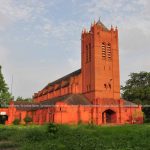Rifa-e-aam
Progressive Writing, Regressive Caretaking
Prashant Nigam
On 10th of April 1936, in this very place in Lucknow the historic Progressive Writers Movement was set up under the leadership of Syed Sajjad Zahir and Ahmed Ali. Syed Fakhruddin Balley was invited by both Syed Sajjad Zahir and Ahmed Ali to join the historic movement. The list further increased when great writers like Faiz Ahmed Faiz, Ahmed Nadim Qasmi, Saadat Hasan Manto, Ismat Chughtai, Majaz Jazbi, Majrooh Sultanpuri and many more were happy to join them.
Rifa-e-Aam club revolutionized literary writings in 1936. It was the native home of the Progressive Writers’ Association. It was patronized by Sahitya Samrat (Emperor of Hindi writing)Munshi Premchand. But today this place is in deteriorating condition, it is hard to take a round of the building. The reason behind it is that this place is used as garbage dumping site by enroachers, rag-pickers and trespassers. No government agency or Municipal Corporation takes heed of this place. However, local people, literary lovers, social workers and budding writers have raised their voices for the restoration of this glorious place. That’s why they have used Munshi Premchand’s name to promote their cause.
The magnificient building, Rifa-e-Aam Club was constructed by the royal Kings and Nawabs of Awadh. It was meant for the royal Indian families to be used as a club for the satiation of their literary hunger and passion.
Lucknow’s Golaganj area witnessed the establishment of this club in 1860. At that time under the British rule, Indians were not allowed to take membership in the United Services Club, Chhatar Manzil. So, the royal families conceived this novel idea of setting up their own club and this is how Rifa-e-Aam was born.
This club also has a very major role in India’s freedom struggle. In 1905, when Bengal was divided and Swadeshi Movement was launched, the meetings of Muslim League were held in this club. This club has proudly witnessed the famous session of The Progressive Writers Association organized by the writers in 1936 and the session was presided by the greats like Saadat Hasan Manto, Munshi Premchand etc. Bal Gangadhar Tilak, Pandit Jawahar Lal Nehru, Mahatma Gandhi and many more freedom fighters visited this club during their visit of 15th October, 1920.

Symbol of Rebellion: The Club dignifies the resistance and hostility against the British who banned the entry of Indians to their clubs. The club also united the literary minds and ignited their thoughts to write for the support of freedom struggle and reminded Indians about their glorious history. This instilled the confidence among Indian mass to rise collectively against the unruly British.
Progressive Thought: The Progressive Writers Association was born in this building where Munshi Premchand gave a call to writers and poets to write about the different types of oppressions and injustices done by the British. This gave a stage to writers to reveal the British harshness and their real motives of ruling India. This revealed the difference in the words and actions done by British. It also revealed the contemporary realities and other voices being raised in some other countries for freedom from the British rule.
Witness of Freedom struggle: Awadh was one of the main centres of Indian Freedom Movement and the Nawabs were also fighting for this cause. Leaders like Pandit Nehru, Gandhiji, Lokmanya Bal Gangadhar Tilak, Lal Bahadur Shastri, Lala Lajpat Rai and many more gave historic speeches here. The association lent an ideological substance and utilized the very moment as a weapon to the freedom stuggle of India.
The club challenged the British rule on several occasions. The club was built by the Nawabs as a spot for holding events to bring ‘rifa’ or happiness to all, including the ‘aam aadmi’ or common man. The club became the insignia of insolence when it gained patronage of Raja Mehmoodabad. He established it as a club for union of common Indians at a time when placard of ‘dogs and Indians not allowed’ hung outside the places like United Services Club and Mohammed Bagh Club.
The Indian National Congress and Muslim League signed the famous Lucknow Pact (1905) at this building.
Writer is a student of Management and has a keen interest in reading and World Affairs
(Published in The Lucknow Observer, Volume 2 Issue 17, Dated 05 August 2015)

Rifa-e-Aam Club




